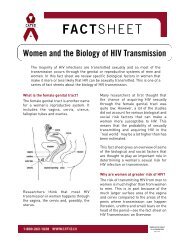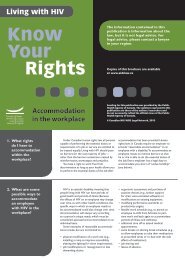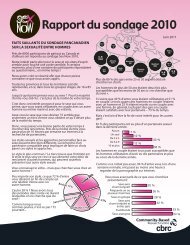You also want an ePaper? Increase the reach of your titles
YUMPU automatically turns print PDFs into web optimized ePapers that Google loves.
<strong>Anabolic</strong> <strong>Steroids</strong><br />
ROIDS/SLOP/JUICE/SAUCE<br />
Whatever you’re<br />
calling it, you<br />
should know the<br />
BASIC FACTS ON<br />
SAFER INJECTING
1<br />
Table of Contents<br />
What are <strong>Anabolic</strong> <strong>Steroids</strong>? 2<br />
If you are using or are planning to use steroids, getting the facts will help you lower<br />
the risk of hurting yourself or damaging your health. This booklet has information<br />
on safer steroid use, safer injecting, equipment you will need, and the possible<br />
side effects associated with using steroids. It also has information on what you<br />
need to know about HIV and hepatitis if you are injecting steroids.<br />
Sometimes things can go wrong if you share injection equipment, use<br />
contaminated steroids, or don’t inject properly. You can reduce your risks by<br />
following the safer injection and harm reduction tips given in this booklet.<br />
Five Messages for Steroid Users:<br />
❱ Use your own sterile equipment each time you inject.<br />
❱ Plan ahead. Get needles and safer injecting supplies<br />
from your local needle and syringe program or pharmacy.<br />
❱ Inject properly and in the right areas.<br />
❱ Dispose of needles safely.<br />
❱ Get regular medical checkups and know<br />
the possible side effects to look for.<br />
There are<br />
laws regarding<br />
performance-enhancing<br />
drugs. In some cases,<br />
steroids are prescribed by a<br />
physician for certain medical<br />
conditions. This booklet does<br />
not provide information<br />
about the law on<br />
steroids in Canada.<br />
Dependence 2<br />
Side Effects 3<br />
Possible Unwanted Side Effects 4<br />
Know Your Stuff 5<br />
Equipment 6<br />
Safer Injecting<br />
Getting Ready 8<br />
Drawing up from an ampoule or a vial 8<br />
Before Injecting 9<br />
Where to inject? 10<br />
Steps for safer injecting 13<br />
After Injecting 14<br />
Risks 15<br />
Hepatitis 16<br />
HIV 18
2 3<br />
What are <strong>Anabolic</strong> <strong>Steroids</strong>?<br />
<strong>Anabolic</strong> steroids are synthetic drugs developed to mimic (have the same effect on<br />
the body as) the natural hormones testosterone and dihydrotestosterone. These<br />
hormones increase the muscle mass of the body. Testosterone is also the hormone<br />
that naturally causes changes in facial hair, deepening of the voice, sex drive, and<br />
development of the penis and testicles.<br />
<strong>Anabolic</strong> steroids cause muscle building that increases strength and muscle bulk.<br />
There are many different types and brands, and they can be taken in pill form or<br />
through injections. Usually, there is a period of use (cycle) followed by a period of<br />
no use to give the body time to adjust and heal. The lengths of these cycles and rest<br />
periods depend on the drug, the dose and how your body reacts.<br />
People choose to take anabolic steroids for lots of different reasons, such as:<br />
❱ increasing strength and muscle mass ❱ increasing energy<br />
❱ decreasing body fat ❱ improving sporting performance<br />
❱ improving body image ❱ peer pressure<br />
Dependence<br />
Some people may become psychologically dependent on steroids and can go<br />
through withdrawal when they stop taking them. Withdrawal symptoms include<br />
mood swings, low sex drive, depression, nausea, headaches, sweating, tiredness<br />
and anxiety. If you are worried you may be becoming dependent on steroids, talk<br />
openly to a healthcare provider.<br />
Side Effects<br />
All drugs can potentially cause<br />
unwanted side effects, and anabolic<br />
steroids are no different. There are many<br />
possible unwanted side effects from using<br />
steroids and they can affect everyone differently. Do<br />
your research; some steroids don’t work well together;<br />
others are not made to be taken by people. It’s important<br />
to get regular medical checkups with your healthcare<br />
provider (doctor or nurse practitioner) because some<br />
of these side effects are dangerous and can be hard<br />
to spot. The general rule is the higher the dose, the<br />
higher the risk of unwanted side effects.<br />
Although it can be difficult to speak with your<br />
healthcare provider, open and honest communication<br />
is an important part of your health. When you feel<br />
comfortable, talk to your care provider about your<br />
steroid use. They can help you monitor your health<br />
during your use and may be able to help you minimize<br />
or manage some of the unwanted side effects. Blood<br />
work should be collected before you start your cycle<br />
along with an ECG (a quick painless heart test). You<br />
should also get a checkup after your cycle to see how<br />
your body is coping.
4 5<br />
Possible Unwanted Side Effects<br />
Body Changes<br />
❱ hair loss ❱ acne on your face, back, chest and shoulders<br />
❱ body rash ❱ increased body hair<br />
❱ breast development (in men) ❱ shrinking of testicles<br />
Mood Changes<br />
❱ aggression ❱ mood swings or depression<br />
❱ insomnia (trouble sleeping) ❱ paranoia<br />
Health Risks<br />
❱ heart problems and palpitations (changes in your heartbeat)<br />
❱ jaundice (yellowing of the skin and eyes) and liver damage/cancer<br />
❱ decreased sex drive, decreased fertility or lower sperm count<br />
❱ impotence (difficulty keeping an erection) or prostate cancer<br />
❱ high blood pressure, blood clots or stroke<br />
❱ sodium and water retention ❱ headaches<br />
❱ muscle and tendon injuries ❱ kidney damage<br />
Unwanted side effects are more common in women because the female body<br />
naturally produces a lower amount of testosterone than the male body does.<br />
Some side effects are also unique to women, including deepening of the<br />
voice, enlargement of the clitoris, drying of the vagina, and changes to the<br />
menstrual cycle.<br />
These risks can be made worse if you already have a medical condition or a<br />
mental health issue, use street drugs, smoke cigarettes or drink alcohol.<br />
Know Your Stuff<br />
Any steroids bought online or on the street (underground market) are not quality<br />
controlled. There is no guarantee that what is on the label is actually in the<br />
container. Never buy loose tablets or ampoules/vials.<br />
What to look for:<br />
❱ packaging is sealed and intact<br />
❱ print on the labels is the same and clear on all ampoules/vials<br />
❱ expiry date has not been exceeded (if they’ve expired or there<br />
isn’t an expiry date don’t use them)<br />
❱ all ampoules/vials in the pack should have the same lot number<br />
and the same expiry dates<br />
❱ rubber stopper and metal<br />
covering are secure<br />
❱ liquid in the ampoules/vials is clear<br />
and there are no floating bits<br />
❱ all the ampoules/vials look the same<br />
and have the same amount of liquid<br />
in them<br />
If anything looks suspicious THINK<br />
TWICE
6 7<br />
Equipment<br />
❱ New sterile equipment needs to be used for each injection.<br />
❱ Cleaning equipment that has already been used will not kill all of the bacteria or<br />
viruses that may be inside.<br />
❱ Injection equipment should NOT be shared, as there is a high risk of hepatitis C<br />
and HIV transmission.<br />
What you need<br />
1. A sterile syringe a 2 – 3 ml syringe<br />
3. Alcohol swabs to clean the injection<br />
site and the stoppers of multi-dose vials.<br />
2. Sterile Needles two needles: one to draw up the<br />
solution from the vial or ampoule and another to<br />
inject the drug into your muscle -- you don’t want<br />
to use the same needle twice because it can<br />
get dull<br />
a• an 18 – 23 gauge needle that is 1 to 1½ inches<br />
long, to draw up the drug (the “drawing up” needle)<br />
b• a 21 – 25 gauge needle that is 1 to 1½ inches long,<br />
to inject into the muscle (the “injecting” needle)<br />
Needle<br />
Syringe<br />
4. A biohazard container to put used needles<br />
and equipment in. This will prevent anyone else<br />
from getting hurt accidentally. If you do not have<br />
a biohazard container, any hard plastic container<br />
with a lid, like a pop bottle or laundry detergent<br />
bottle, will work.<br />
Tips<br />
❱ You should not inject more than 2 ml of fluid into a muscle at one<br />
time. Injecting more than 2 ml affects how the drug is absorbed AND<br />
increases your risk of developing abscesses.<br />
❱ The thickness of the needle is measured in gauges (the smaller the gauge the<br />
thicker the needle). The needle must be THICK enough for the drug to pass<br />
through (oil-based steroids need a thicker needle) and LONG enough<br />
to reach into your muscle (if injecting in the buttock you will need a<br />
longer needle).
8 9<br />
Getting Ready<br />
Things can go wrong when you inject incorrectly, share injection equipment, or<br />
use contaminated drugs. You can reduce your risk by following the safer injection<br />
and harm reduction tips given in this booklet.<br />
Find a clean spot to lay out all your equipment. Wash your hands well with soap<br />
and water before handling any injection equipment.<br />
Drawing up from an ampoule or a vial<br />
❱ Allow steroids that need to be refrigerated to warm up to room temperature<br />
before injecting. This helps reduce the shock to the muscle when you inject and<br />
improves absorption of the steroid into the body.<br />
❱ Attach a sterile “drawing-up” needle to a sterile syringe.<br />
❱ AMPOULE<br />
• Open the ampoule. Be careful not to cut yourself.<br />
• Insert the needle and draw back the plunger until the amount of drug you<br />
want is in the syringe.<br />
❱ VIAL<br />
• Open the vial.<br />
• Clean the rubber stopper with an alcohol<br />
swab.<br />
• Push the needle through the rubber<br />
stopper and inject a small amount of<br />
air into the vial to regulate the pressure.<br />
This makes it easier to draw up the drug<br />
into the syringe.<br />
• Draw the plunger back until the amount of<br />
drug you want is in the syringe.<br />
❱ When using two or more substances, make sure you don’t accidently mix the<br />
drugs from one bottle to another.<br />
❱ Remove the drawing-up needle from the syringe and put it in your biohazard<br />
container.<br />
❱ Attach your new sterile injecting needle to the syringe. Leave the cap on the<br />
needle until you are ready to inject.<br />
Before Injecting<br />
❱ Get rid of any air bubbles in the syringe before injecting. Hold the syringe<br />
pointing upward, flick the barrel to move any bubbles to the top, and then push<br />
the plunger slowly to get rid of any air.<br />
❱ When you can’t see any bubbles and a tiny drop of the drug appears at the<br />
needle tip, it is ready for injection.
10 11<br />
Where to inject?<br />
❱ <strong>Anabolic</strong> steroids should only be injected into a muscle, never a vein. The largest<br />
muscles (buttock, hip and thigh) are the best and safest places to inject.<br />
❱ Remember to rotate your injection sites to avoid tissue damage in one area. If<br />
you feel a hard lump in your muscle, use a different injection site.<br />
❱ If you are not sure where to inject or if you can’t reach, ask your care provider to<br />
show you how and where to inject.<br />
❱ Since steroids work throughout the body and not just where they are injected,<br />
you don’t need to target specific muscles with injections.<br />
The Butt<br />
This is another large muscle that is good for injection. Divide the buttock into four<br />
blocks, inject in the upper outer block in either the left or right buttock.<br />
DO<br />
The Hip (Ventrogluteal)<br />
This is the safest muscle for injection because there are no major nerves or blood<br />
vessels in the area. It can be a little tricky to find on your own body, so it’s best to<br />
have a healthcare provider or friend help you locate the site for the first few times.<br />
Place the palm of the opposite hand (right hand for left hip, left hand for right hip)<br />
over the end of your thigh bone (femur) and your index finger on the bony part at<br />
the front of your pelvis. Then spread the middle finger out towards the top of your<br />
hip bone; the injection site is in the ‘V’ your fingers make.<br />
DON'T<br />
DON'T<br />
Sciatic NervePath<br />
front of pelvis<br />
top of hip<br />
DO<br />
end of leg bone<br />
The sciatic nerve is located in the centre of each<br />
buttock (shown in yellow). Hitting the sciatic nerve is<br />
very painful and can cause permanent nerve damage.
12 13<br />
The Thigh<br />
Inject in the vastus lateralis (the middle outer muscle) of either thigh.<br />
DO<br />
The Shoulder<br />
Find the tip of your shoulder bone and inject three fingers down. This is not the<br />
best injection site because it is a smaller muscle. Injecting here can cause more<br />
damage and pain.<br />
Steps for safer injecting<br />
❱ Use a new alcohol swab to clean your injection site area. Rub the area for 30 seconds.<br />
❱ Remove the plastic cap from the needle. The needle should not touch anything<br />
before injection.<br />
❱ Hold the syringe like a dart and slightly spread the skin of the injection site using<br />
your other hand.<br />
❱ With a quick movement, push the needle through the skin and into the muscle at<br />
a 90 degree angle. Only insert three-quarters of the needle so it can be removed<br />
more easily if the needle breaks.<br />
❱ Pull the plunger back a little bit; if blood is drawn into the syringe, remove the<br />
needle quickly, and apply pressure for a minute using a cotton ball. Discard this<br />
needle in your biohazard container and start preparing a new injection and<br />
using a different site.<br />
❱ If no blood is drawn into the syringe, continue with injection by slowly pushing<br />
the plunger to minimize tissue damage.<br />
❱ After injecting, remove the needle quickly and apply pressure for a minute with<br />
a cotton ball where the needle was injected.<br />
DO
14 15<br />
After Injecting<br />
❱ A small amount of bleeding from where the needle broke the skin is normal. You<br />
may also have a bit of swelling, redness, pain, itching or burning at the injection<br />
site. These symptoms should go away in one or two days. If the site is still red and<br />
hot after two days, talk to your healthcare provider right away.<br />
❱ Wash your hands well with soap and water.<br />
❱ Gently massage the injection site to help distribute the steroid.<br />
❱ Put needles, syringes and empty ampoules/vials in a biohazard container.<br />
Return the biohazard container to your local needle and syringe<br />
program once the container is about three-quarters full.<br />
Risks<br />
Abscesses<br />
An abscess is an infection at the injection site. Abscesses can be caused by bacteria<br />
that get under the skin when the site isn’t cleaned before injecting or from reusing<br />
injection equipment. They can also be caused by a steroid that is not fully absorbed<br />
from the injection site. This can happen when you inject too much at one time<br />
or don’t insert the needle far enough into the muscle. When this happens, the<br />
drug pools in the muscle and can break down the tissue, causing an infection.<br />
Symptoms of an abscess are an injection site that is red, hot, painful/burning;<br />
scarring or a hard lump at the site; or a fever. You should see a healthcare provider<br />
if you have any of these symptoms. Many abscesses need special treatment or<br />
antibiotics. If an abscess is not treated, a more serious blood infection can occur.<br />
Pain or spasm<br />
Pain or spasm can be caused by not injecting in the right place or using the same<br />
injection site over and over. Pain can be a sign of damage to a muscle, tendon<br />
or ligament. Lasting muscle pain or spasm can end up affecting how well your<br />
muscle works. Remember to rotate sites and take the time to find the right place<br />
each time you inject.<br />
Hitting a nerve<br />
If you hit a nerve, it’ll be painful. If this happens, remove the needle. Severe nerve<br />
damage can happen, which could be permanent and which could affect your<br />
ability to move (paralysis).<br />
Bleeding that won’t stop<br />
Injecting into a blood vessel can lead to bleeding inside the muscle and visible<br />
bruising. This can cause muscle pain and stiffness. Always remember to make<br />
sure your needle is not in a blood vessel before injecting (see Injecting Steps,<br />
page 13). Some medications, like blood thinners, increase the risk of serious<br />
bleeding after injecting.
16 17<br />
Hepatitis<br />
Hepatitis is a virus that affects the liver. It can cause inflammation (swelling) and depending<br />
on the type of hepatitis (Hep), over time, it could lead to scarring and liver damage.<br />
Hep A, Hep B and Hep C are the three most common types of hepatitis in Canada.<br />
Hepatitis A<br />
There is no risk of Hep A from steroid use. Hep A is spread through oral contact<br />
with the feces (poo) of a person with hepatitis A and can be in food or water. It is<br />
possible to get hepatitis A from oral-anal sex (rimming).<br />
Hepatitis B<br />
There is a risk of Hep B from steroid use. Hepatitis B is spread by contact with<br />
infected blood. It can also be spread by other body fluids like semen (including<br />
pre-cum), vaginal fluids, saliva (spit) and breast milk. Most people can fight Hep<br />
B, but there are medicines to help control the virus, too. Hepatitis B CANNOT be<br />
spread by casual contact with someone.<br />
The virus is passed by:<br />
❱ sharing needles or other equipment used for injecting steroids or other drugs<br />
❱ unprotected oral, vaginal or anal sex<br />
❱ sharing personal hygiene tools (toothbrushes, razors, nail clippers, etc.)<br />
❱ sharing equipment used for tattooing or piercing<br />
❱ sharing equipment used for snorting or smoking drugs (pipes, straws, paper money, etc.)<br />
❱ a mother to her baby during pregnancy, birth or breastfeeding<br />
Hepatitis C<br />
There is a risk of Hep C from steroid use. Hep C is spread through blood-to-blood<br />
contact. Hep C can live for weeks outside of the body so it is important to never<br />
share injection equipment. A Hep C infection can happen when blood carrying<br />
the virus gets into the bloodstream of another person.<br />
The virus is spread by:<br />
❱ sharing needles or other equipment used for injecting steroids or other drugs<br />
❱ having unprotected sex where blood could be present (like during rough sex,<br />
anal sex or sex when a woman is on her period)<br />
❱ sharing personal hygiene tools (toothbrushes, razors, nail clippers, etc.)<br />
❱ sharing equipment used for snorting or smoking drugs (pipes, straws, rolled<br />
dollar bills, etc.)<br />
❱ sharing equipment used for tattooing or piercing<br />
Signs and Symptoms of Hepatitis B & C<br />
Most people don’t have any symptoms when they get hepatitis, and there may<br />
not be any symptoms for years. By the time signs appear, liver damage could<br />
be serious. During this whole time the virus can be passed on to other people.<br />
Symptoms could be:<br />
❱ tiredness all the time ❱ body aches and fever<br />
❱ dry, itchy skin ❱ abdominal pain, nausea and vomiting<br />
❱ jaundice (yellowing of the skin and whites of the eyeballs)<br />
If you think you might be at risk or have any of these symptoms see a healthcare<br />
professional for hepatitis testing.<br />
How do I protect myself from<br />
hepatitis B and C?<br />
You can get a vaccination (shot) to prevent getting hepatitis A or B, but there is no<br />
shot for Hep C. There is also treatment for Hep B and C but first you have to get<br />
tested to know if you have the virus.<br />
If you think you are at risk for infection or have been infected, it is important to find<br />
out so you can take steps to protect yourself and others.
18 19<br />
HIV<br />
HIV (Human Immunodeficiency Virus) is a virus that weakens the immune<br />
system, the body’s natural defense against sickness and disease. If a person has<br />
HIV and doesn’t know it, they could develop other illnesses and infections that<br />
could have a big impact on their health and pass HIV onto others. If HIV is not<br />
treated with anti-HIV drugs, a person can become sick with a life-threatening<br />
infection called AIDS.<br />
There is no cure for HIV, but with proper care and treatment, most people with HIV<br />
stay healthy for a long time.<br />
How is HIV transmitted?<br />
• HIV is found in blood, semen (including pre-cum), vaginal fluids, rectal fluids and<br />
breast milk.<br />
• HIV can be passed when one of these fluids from a person with HIV gets into the<br />
bloodstream of another person -- through broken skin, the opening of the penis<br />
or mucous membranes (the wet linings of the body) such as the vagina, rectum<br />
and foreskin.<br />
The two main ways HIV can be passed are:<br />
❱ sharing needles or other equipment used for injecting steroids or other drugs<br />
❱ unprotected sex (vaginal or anal sex without a condom) – oral sex is not as risky,<br />
but it’s not completely safe<br />
HIV can also be passed by:<br />
❱ sharing sex toys<br />
❱ sharing piercing and tattoo equipment<br />
❱ the mother to a baby during pregnancy, birth or breastfeeding<br />
Signs and Symptoms of HIV<br />
Some people have flu-like symptoms when they first become infected (fever, sore<br />
throat or swollen glands). These symptoms usually go away after a few days and a<br />
person can have no signs of infection for years.<br />
The only way to know if you have HIV is to get tested. It’s recommended that<br />
anyone who is sexually active and people who are injecting steroids or other<br />
drugs get an HIV test at least once a year and after any exposure risk.<br />
How do I protect myself from HIV?<br />
HIV is easily prevented. Using new sterile needles every time you inject and using<br />
condoms, lube and/or dental dams when you have sex significantly reduces the<br />
risk of getting or passing HIV.<br />
Practicing safer injecting and safer sex are the best ways to protect<br />
yourself and others from hepatitis and HIV.
20 21<br />
NOTES<br />
Acknowledgements:<br />
Writers: Kira Mandryk and Rick Dias, Ottawa Public Health, Healthy Sexuality &<br />
Risk Reduction Unit<br />
Copyeditors: Anna Kohn, Louise Slocombe<br />
Translation: Ottawa Public Health<br />
Thank you to Paul Perry MN NP(PHC) who reviewed this resource.
You can reduce your risks by following the safer injection and harm reduction tips given<br />
in this booklet. You can pick up needles, safer injecting supplies and more information<br />
on safer steroid injection from your local needle and syringe program. Although it might<br />
be difficult, we encourage you to talk to your healthcare provider about your steroid use<br />
so that you can be as safe as possible.<br />
Need more information and resources on HIV or hepatitis C?<br />
Contact <strong>CATIE</strong>: 1.800.263.1638 • www.catie.ca • info@catie.ca<br />
<strong>CATIE</strong> Ordering Centre Catalogue Number: ATI-26426<br />
(aussi disponible en français, ATI-26427)<br />
Nationalized and reprinted with assistance from <strong>CATIE</strong>, 2013. Production has been made possible through a<br />
financial contribution from the Public Health Agency of Canada (PHAC). The views expressed in this resource do not<br />
necessarily reflect the views of the Public Health Agency of Canada.<br />
© Ottawa Public Health, 2013

















